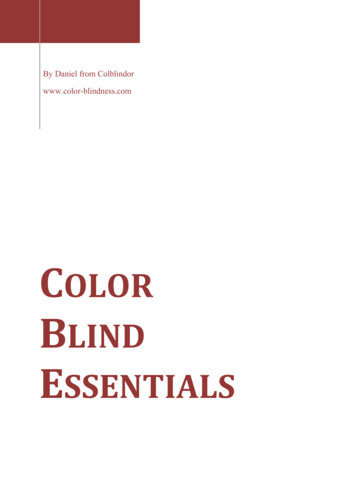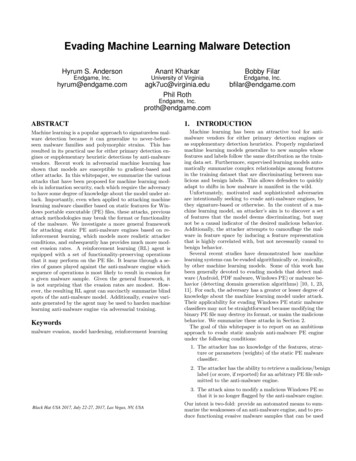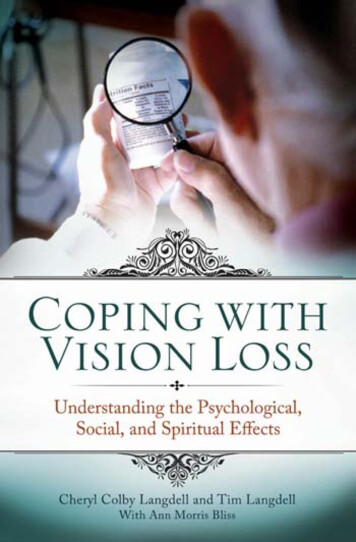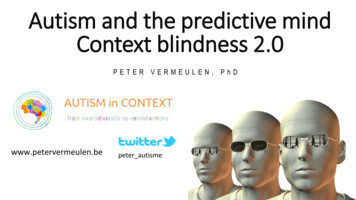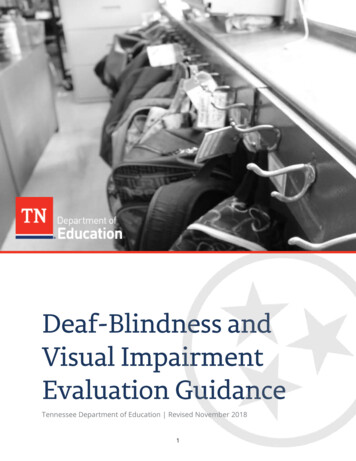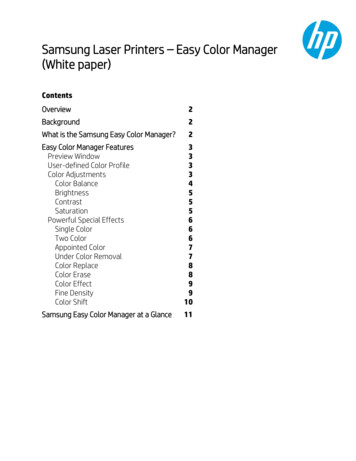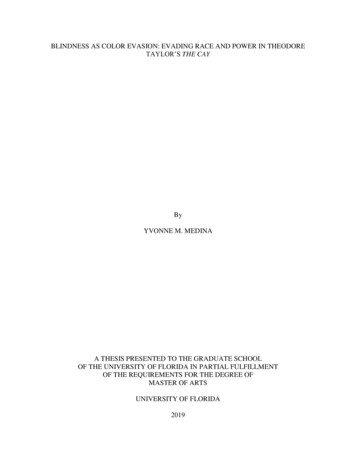
Transcription
BLINDNESS AS COLOR EVASION: EVADING RACE AND POWER IN THEODORETAYLOR’S THE CAYByYVONNE M. MEDINAA THESIS PRESENTED TO THE GRADUATE SCHOOLOF THE UNIVERSITY OF FLORIDA IN PARTIAL FULFILLMENTOF THE REQUIREMENTS FOR THE DEGREE OFMASTER OF ARTSUNIVERSITY OF FLORIDA2019
2019 Yvonne M. Medina
To my parents, Theresa and Frank, and my sister, Genevieve
ACKNOWLEDGMENTSI would like to express gratitude to the many people who have inspired and shaped myresearch on The Cay. Dr. Steverson provided me with tremendously valuable sources andguidance on my seminar paper which evolved into this thesis. Dr. Kidd, my adviser on thisproject, has been a tireless support. His superb direction of this project is deeply appreciated. Iwould also like to thank Dr. Mennel who offered invaluable critiques and guidance on improvingthe stylistics of the paper.I would like to express appreciation to the Children’s Literature Association for theopportunity to present a portion of this paper at its annual conference. Jill Coste helped meformulate my first conference abstract by offering insightful recommendations. I would also liketo give special thanks to Andrea Medina for her editorial attention to detail. I am thankful forJohn Mark Robison’s thoughtful and meticulous comments on my draft. I would like to creditmy colleagues who shared with me their familiarity with The Cay in pedagogical contexts. I owegratitude to my peers in Dr. Steverson’s Critcial Disability Studies seminar who offered feedbackin the project’s early stages. And I am deeply indebted to my parents and my sister to whom thiswork is dedicated. They read and critiqued my work at every stage of its evolution.Finally, I would like to express sincere thanks to Ms. Kazcak, my seventh grade Englishteacher who taught The Cay. Her pedagogy encouraged me to study literature with a critical eye.She made me wonder why a happy ending for a children’s book necessitated a cure fromdisability.4
TABLE OF CONTENTSpageACKNOWLEDGMENTS .4ABSTRACT .6CHAPTER1INTRODUCTION .81.1 Reception History .121.2 Critical History .142BLINDNESS AND BIGOTRY .172.1 A Beauty and the Beast Story .172.2 Blindness as Insight .182.3 Blindness as a Lesson in Development .243REVILING AND EROTICIZING THE OTHER .283.1 Beyond Leslie Fiedler .283.2 Politics of Perspective: Return to The Cay .30LIST OF REFERENCES .40BIOGRAPHICAL SKETCH .425
Abstract of Thesis Presented to the Graduate Schoolof the University of Florida in Partial Fulfillment of theRequirements for the Degree of Master of ArtsBLINDNESS AS COLOR EVASION: EVADING RACE AND POWER IN THEODORETAYLOR’S THE CAYByYvonne M. MedinaMay 2019Chair: Kenneth KiddMajor: EnglishTheodore Taylor dedicated his children’s book The Cay in 1969 to Dr. Martin LutherKing’s dream, and many educators praise it as antiracist. Unfortunately, the book reinscribes theracism it attempts to critique by using the metaphor of blindness to evade issues of race andpower. The main characters in this novel are Phillip, a white American boy leaving Curaçaoduring World War II, and Timothy, an elderly Black sailor from St. Thomas. They survive aGerman torpedo blast and find themselves struggling to subsist on an uninhabited island in 1942.Phillip becomes blind while they are adrift on their raft.Phillip’s blindness serves as an evolving metaphor in the novel, at first signaling hisbigotry but then transforming into the ostensibly opposite “color-blindness.” He claims not toobserve racial difference in skin tone due to his blindness. Color-blindness here is not theinability to see a full spectrum of color, the medical definition; rather, it is a refusal to observedifferences in skin color and the ways one’s skin color limits opportunities and access toresources. Phillip clings to a color-blind racial ideology that both refuses to recognize racialdifference and question the underlying power structures of systemic racism. A better term forPhillip’s color-blindness is color evasiveness because it emphasizes his reluctance to discussracial inequality rather than blaming it on ignorance. I will integrate the critical lenses of both6
critical race theory and critical disability studies to examine how the metaphor of blindnessperpetuates color-blind racial ideology.7
CHAPTER 1INTRODUCTIONTheodore Taylor dedicated his children’s book The Cay in 1969 to Dr. Martin LutherKing Junior’s dream. Dr. King dreamed of “the time when a man will be judged for the contentof his character and not for the color of his skin.” Taylor misunderstood King’s message of racialequality and employed the metaphor of blindness to encourage ignoring skin color. On thesurface, this book seems to convey a progressive message of racial understanding. Unfortunately,the novel reinscribes the racism it ostensibly attempts to critique by using the metaphor ofblindness to evade issues of race and power. The novel’s wide circulation in public schoolcurricula makes its ideological conservatism even more insensitive.This historical novel centers on a racist white boy, Phillip, who becomes blind during theeve of World War II and finds himself living on a small island1 with an elderly Black man namedTimothy. First-person narration reveals the white boy’s racist thoughts through derogatorydescriptions of his Black companion. Blindness serves as a metaphor for his bigotry, whichevolves into color-blindness as he learns to ignore the Black man’s skin color. He claims not toobserve racial difference in skin tone due to his blindness. Color-blindness, as it is presented andimagined in the novel, is not a medical inability to see a full spectrum of color; instead, it is arefusal to observe differences in skin color and the ways one’s skin color limits opportunities andaccess to resources by inviting racial discrimination. Defenders of the novel practice an insidiousform of racism known as color-blindness. They claim not to “see” race or one’s skin color butinstead see the person beneath the skin color. Color-blindness denies a celebration of racialA cay is a “low, sandy islet” according to Theodore Taylor’s prefatory materials in Timothy of the Cay. Hisexcerpt from a Dictionary of Virgin Islands specifies that the word cay is “Sometimes spelled and pronouncedKEY.” This alternate spelling suggests a double meaning in the title since a key serves as a powerful metaphor forunlocking a barrier and increasing one’s understanding of a concept.18
difference and fails to acknowledge systemic issues of racism. The novel’s depiction of blindnessadvances color-blind racial ideology2 by erasing racial difference in addition to evading issues ofsystemic racism. In doing so, it also belittles blindness as a viable way of life with a unique wayof sensing the world. I suggest the term color evasion as a replacement for color-blindnessbecause it makes apparent how people who claim to be color-blind actively evade issues of raceand power3. Color evasion critiques the ideology of color-blindness. The portrayal of disabilityas granting one special insight to transcend the racist gaze complicates the racism in The Cay.Although critics have separately condemned the novel’s racism and its depiction of disability,there is not a sustained inquiry into how the metaphor of blindness perpetuates color-blind racialideology. I argue that the promotion of blindness or willful ignorance as a solution to bigotryreduces racism to an ocular problem and discourages readers from interrogating racial inequalitymore deeply.Taylor’s depiction of race relations was widely debated in the 1970s4, especially inrelation to his acceptance of the Jane Addam’s Children’s Book Award which honors children’sbooks “that effectively engage children in thinking about peace, social justice, globalcommunity, and equity for all people” (Jane Addams Peace Association). The text’s complexreception history and continued widespread acceptance among many children’s librarians andeducators overshadow the problems with its depiction of disability. The Cay’s ongoing curricular2Sociologists use the term color-blind racial ideology or CBRI to describe the color-blind belief system that protectswhite guilt.3Ruth Frankenberg coined the term color evasiveness in her book White Women, Race Matters: The SocialConstruction of Whiteness.4Albert Schwartz, the former Vice President of the Council for Interracial Books for Children, wrote a critical essay“The Cay: Racism Still Rewarded” and Binnie Tate, a librarian in Los Angeles criticized the book in her articletitled “In House and out House: Authenticity and the Black Experience” in the School Library Journal. Activists andeducators voiced their opinions in a press conference protesting the TV movie of The Cay in 1974.9
status and circulation propagate reductive racist and ableist views. Color-blindness evades issuesof race and power, denying the existence of racial difference and positing sightedness as thesource of racism. The depiction of blindness also stigmatizes the condition by portraying it as alesson in moral development.The main characters in the novel are Phillip Enright, a white American boy leavingCuraçao during World War II, and Timothy, an elderly Black sailor from St. Thomas. Timothyleaves his retirement in order to aid in the war effort when he notices that the Allies need ablebodied seamen. Phillip turns twelve during his time on The Cay and Timothy estimates his age tobe in the seventies. They both survive a German torpedo blast, clamber onto a raft with a cat, andfind themselves struggling to subsist on a small, uninhabited island in 1942. Phillip becomesblind while they are adrift on their raft, a condition that results from a blunt impact to his headwhen he falls off the ship and from staring too long at the sun’s reflection on the water, whichTimothy warned him against. After four days of drifting on a raft through shark infested waters,they reach a small desert island. Timothy shoulders much of the physical burdens related to theirsurvival while he teaches Phillip how to navigate the island. Ultimately, Timothy martyrshimself in a hurricane to save Phillip’s life. He straps them both to a palm tree and shields Phillipwith his body, bearing the brunt of the storm. It is only after Phillip buries Timothy that he getsrescued and undergoes a medical procedure that restores his sight.Disability centrally shapes the didacticism, plot, and character development in The Cay.Theories of bodily inscription connect issues of racism and disability. David Mitchell and SharonSnyder’s theory of narrative prosthesis is useful for considering how blindness functions in thenovel. They examine how narratives “turn signs of cultural deviance into textually markedbodies” by inscribing cultural anxieties onto the body (Narrative Prosthesis 21). They claim that10
disability serves as a narrative crutch, an opportunistic metaphor for a cultural anxiety. Thenarrative leans on this crutch to make a larger point about a societal flaw. Ocular sight is the siteof racism, or the racist gaze, in The Cay. The abstract nature of the racist gaze makes it difficultto represent in a children’s book, so Taylor uses blindness as a metaphor for bigotry whichevolves into color-blindness, or more properly color evasiveness. Mitchell explains thisinscription as “The passage through a bodily form helps secure a knowledge that wouldotherwise drift away of its own insubstantiality. The corporeal metaphor offers narrative the onething it cannot possess – an anchor in materiality” (Dependencies of Discourse 63). According toMitchell and Snyder’s theory, disability functions as a prosthetic, a plot device that serves as ahinge upon which the narrative turns. Disability is the problem “a narrative issues to resolve orcorrect.a deviance marked as improper to a social context;” the narrative impulse is torehabilitate the deviance through a cure (The Dependencies of Discourse 53). The Cay presentstwo cures: Phillip’s supposed antiracist transformation and the operations that reward him byrestoring his sight.The suffering Phillip endures purportedly transforms him from a spoiled, bigoted child toa more compassionate and self-sufficient one, though some critics contend that Phillip matureslittle over the course of the novel5. Phillip’s first-person narration underscores his primacy in theplot and pushes Timothy to the periphery. His descriptions of Timothy reveal a shockingly racistworld view, a view that materializes as medical blindness. Readers gain access to Phillip’sinteriority through first-person narration, but this unvarying format denies them access to thethoughts of his Black companion. Taylor addresses Timothy’s lack of back story in hisAlbert Schwartz believes that “all that changes in Phillip’s growth is a shift in the direction of his racism” (145).Binnie Tate believes that Taylor “fails in his attempt to to show Philip’s [sic] growth in human understanding” (98).511
companion novel, Timothy of The Cay, published in 1993. Although this book provides moreinformation about Timothy’s upbringing, it still foregrounds Phillip’s perspective. The secondclass status of Timothy’s character has influenced the reception of The Cay.1.1 Reception HistoryThe reception history of The Cay is contentious due to Taylor’s intention to promoteracial understanding and the backlash from critics who believe the book is racist. Nonetheless, itreceived the Jane Addams Children’s Book Award in 1970 for being a “bridge betweengenerations and races built by Timothy’s indomitable courage and compassion” (qtd. in Griffith15). The Council on Interracial Books for Children protested the book when it was adapted to aTV movie with James Earl Jones in 1974 (Banfield 19). A group of educators and activistshosted a press conference in which they condemned the racism in the movie and encouragedviewers to write letters to the network, pleading the company to ban the broadcast (Griffith 15).There, Bertha Jenkinson, the chair of the 1974 Addams Award Committee, “announced that shethought the 1970 Addams Award Committee had made a mistake in naming the book the 1970Jane Addams Children’s Book Award Winner” (Griffith 15). Griffith claims that this statementcreated a “public furor” that prompted Taylor to publish a letter in Top of the News, stating thathe returned the award “by choice; not in anger, but with troubling questions” (qtd. in Griffith19). Taylor claimed that the Jane Addams Award Committee rescinded the award. However, anofficial record of the award’s revocation does not exist and The Cay remains on the award’swebsite. Griffith could find no evidence of the award’s official revocation in the archivalmaterial in the Peace Collection at Swarthmore College. Nevertheless, due to Taylor’s ownaccusation, many people still believe that the committee revoked the award. This false beliefsatisfies many critics while allowing the book’s defenders to read and circulate it further.12
The Cay’s wide reach in elementary, middle, and high school curricula as well as libraryrecommended reading lists exacerbates the problem of its depictions of race and disability. SaraSchwebel reports “In 2010, California, Indiana, New York, North Carolina, and Massachusettsincluded the novel on their respective lists of recommended middle-grade titles” (116). DennisMcLellan claims in an interview conducted with Taylor in 1997 that The Cay “is on requiredreading lists for fifth- and sixth-grade students in 33 states” (1). The same interview reveals thatTaylor received “as many as 500 letters a month from around the country most of them arrivingin batches from entire classrooms of students who have read the book” (McLellan 1). Americanschools still widely use the novel as a pedagogical tool to teach racial understanding andempathy for people with disabilities6. The Cay has sold an estimated 4 million copies, and it hasbeen translated into over 14 languages (Tucker). Schwebel claims “The Cay ranks fifty-seventhamong all-time best-selling children’s paperbacks” (104). She also asserts that it ranked 16th inpopularity among sixth-graders in the Accelerated Readers program in 2010, a national programwhich included 6.2 million students. The widespread circulation of the novel and prevalence inpublic school curricula begs the question of whether educators should teach this book, and if so,how to approach the book’s racism.Some critics believe that educators should teach racist classics within a proper context toencourage students to think critically about racial issues and question the authority of such texts.Phillip Nel believes “These racist classics must be read in the context of other books that offeraffirmative images of racial group members and supply necessary history that will help youngreaders make sense of the structures of racism” (100). Susan Griffith encourages educators to6I had to read The Cay in middle school in Massachusetts and my colleagues have read it for curricular purposes inFlorida, North Carolina, and Arkansas. Susan Griffith mentions a scholar who claims the book is widely read inJamaica (14). She also cites Boston and Michigan as other places where educators use The Cay in curriculum.13
teach the reception history of The Cay to young students and to ask questions from its history todeepen their awareness of systemic racism (22). Schwebel also offers a series of guidedquestions that culminate in the question of whether color-blindness serves a relevant purpose intoday’s society (168-170). Educators need to address issues of reparation and this concept doesnot enter the ideology of The Cay. Stuart Ching contends “when children’s fiction substitutesracial harmony in place of reparation, the work may masquerade as advocacy when, in reality, itsubverts minority causes” (130). The book’s espousal of color-blind racial ideology through itsopportunistic use of disability as a metaphor for color-blindness necessitate a great deal ofcritical reading to unpack these issues. The danger in circulating The Cay further far outweighsthe potential (and largely theoretical) advantages of reading it “critically.” Many educators andstudents miss the promotion of color-blind racial ideology and the use of blindness as a narrativeprosthetic to that end. The lack of critical inquiry on this subject makes it unlikely that educatorsand children will readily grasp this concept.1.2 Critical HistoryThe history of The Cay consists of a flurry of criticism around the book’s publication inthe 1970s and relative silence since then, despite its ongoing circulation. Susan Griffith claims“The passionate critiques of The Cay voiced near the time of its publication stand in starkcontrast to the equally passionate acclamation of readers today” (15). Although these critiqueswere incisive, such as the ones the Council for Interracial Books for Children published, thebook still enjoys a wide circulation. Schwebel believes that books for curricula aim to speak to amainstream America and the radical Council for Interracial Books for Children “never penetratedthe conservative institution of the public school” though they influenced educators, parents,children’s literature scholars, and authors by encouraging a diversity of voices (117).14
The response was polarized at the time of The Cay’s publication; some critics praised thebook’s message of color-blindness while others criticized the book’s racism. For example,Charles Dorsey’s New York Times book review in 1969 is positively glowing; he writes that “allhumanity would benefit from this special form of color-blindness” (85). He suggests everyonecould benefit from adopting Phillip’s brand of racial color-blindness. Conversely, AlbertSchwartz, the vice president of the Council for Interracial Books for Children, denounced TheCay as a “story for white colonialists to add to its racist mythology” (144). He wrote animpassioned critique of the book titled “The Cay: Racism Still Rewarded” at the time of TheCay’s publication. His article critiques the book’s racist message and the absence of Timothy’sbackground in the text. Schwartz also questions Phillip’s character growth: “Midway in the bookPhillip undergoes a conversion or so the author would like the reader to believe” (145). AlthoughSchwartz identifies Phillip’s “conversion” as stemming from his loss of eyesight, he does notinterrogate that metaphor and relate it to the color-blindness espoused in the novel’s message.Binnie Tate also critiques The Cay in her article in the School Library Journal titled “In Houseand Out House: Authenticity and the Black Experience” a year after the book’s publication. Shestates that Taylor “fails in his attempt to show Philip’s [sic] growth in human understanding”(98). Although these two articles criticize the book’s racism, they do not deal with its depictionof disability.Critics generally overlook The Cay’s depiction of disability. Patricia Dunn discusses it inher monograph, Disabling Characters, where she includes a section on how narrative prosthesisfunctions in the novel (79). Although she describes the problems with the deus ex machinamiracle cure and the metaphor of racial prejudice, she fails to connect Phillip’s blindness toissues surrounding color-blindness and its evasions of systemic racism. She ultimately claims15
that Phillip’s story is an “awakening story” about race and contends that Phillip matures over thecourse of the novel. I agree with Schwartz and Tate’s reading that Phillip’s racism has merelyshifted and that he does not mature into a racially aware and appreciative person (Schwartz 145;Tate 98). Phillip’s racism has shifted from outspoken bigotry to the more insidious form of colorblind racial ideology. A reconsideration of this perspective is overdue, especially as informed bycritical disability studies. Phillip’s alleged antiracist transformation occurs according to thepattern of a love story that relies on overlooking appearances.16
CHAPTER 2BLINDNESS AND BIGOTRY2.1 A Beauty and the Beast StoryPhillip’s first impression of Timothy evokes visceral disgust while his final impression isone of gratitude and love. Phillip first meets Timothy on the raft while he still has his sight. Heharshly judges Timothy’s physical appearance, frequently calling him ugly. He narrates “I saw ahuge, very old Negro sitting on a raft near me. He was ugly. His nose was flat and his face wasbroad; his head was a mass of wiry gray hair” (Taylor 23). He equates physical features oftenassociated with people of African descent and the elderly with ugliness. Before Phillip loses hissight he regards Timothy’s appearance with disgust and refers to him often as a “great wall ofblack flesh” (Taylor 27). The perceived racial difference manifests as static barriers of flesh thatare always the result of Phillip’s gaze of Timothy’s body. He describes Timothy on the raft, “theNegro was sitting with his back toward me.a great wall of Black flesh” (Taylor 27) and later as“a mound of silent Black flesh” (29). These depictions of walls of flesh represent Phillip’sperception that their difference in skin pigmentation imposes a barrier which prevents him fromgetting to know Timothy.Phillip’s gaze is colonial, for he looks at the Black body as an object. His thoughtsdisturbingly reduce Timothy’s body to the color of his skin, as that quality overshadows all othercharacteristics in Phillip’s mind. Phillip’s preoccupation with Timothy’s Blackness transformsitself into blindness; suddenly the visual reminder of their difference in pigmentation disappearssince everything Phillip sees is black. After he becomes blind he continues to reify Timothy’sbody by frequently calling attention to its large size, but he no longer refers to his flesh as a wallor mound because this barrier has seemingly been erased or hidden from his view. Phillip andTimothy’s relationship resonates with the Beauty and the Beast narrative. Phillip perceives a17
discrepancy between Timothy’s outward appearance and his intrinsic qualities once he noticesTimothy’s kindness towards him. Naomi Schor analyzes stories like Beauty and the Beast in heressay “Blindness as Metaphor” to explain how willful blindness, or overlooking monstrosity, isintegral to these love stories (86-102). These stories devalue sight by demonstrating how itfocuses one’s attention on external, surface beauty instead of someone’s deeper, inner beauty.Beauty learns to be blind to the Beast’s deformity by ignoring the evidence of her senses andperceiving his true self, an honorable character, underneath his monstrosity. Schor’s reading ofthis blindness as leading to romantic love strangely parallels the relationship between Phillip andTimothy in The Cay. Phillip’s lack of sight allows him to love Timothy platonically because iterases his disgust with Timothy’s body. Schor claims “embodied blindness enables vision topierce monstrosity in relationships between the self and other that lie outside of the carnal,outside of the heterosexual or the homosexual” (91). Phillip perceives Timothy’s darker skincolor as monstrous, equating Blackness with bestiality. The description of Timothy as a mounddehumanizes him and reduces him to an amorphous shape without limbs or identifying features.Phillip’s blindness figures as a special sight that transcends the racist gaze, elevating him aboveother humans who are not endowed with this gift.2.2 Blindness as InsightPhillip’s racial color-blindness does not heighten his racial sensitivity; instead, it erasesdifferences in skin color entirely. He reflects upon skin color when he is blind. Phillip narrates “Imoved close to Timothy’s big body before I went to sleep. I remember smiling in the darkness.He felt neither white nor black” (Taylor 72). Phillip denies any difference in skin color byrefusing to see color, relying on his inability to see color as a way of forgetting that thisdifference exists. Ray Anthony Shepard from the Council on Interracial Books for Childrenclaims that “the stories of the white author/illustrator are oriented toward the liberal insistence on18
human similarities and sameness, whereas the Black author/illustrator celebrates the ethnicdifferences of Blacks” (qtd. in Schwartz 145). Phillip’s blindness erases the ethnic differencesbetween himself and Timothy. He chooses not to acknowledge Timothy’s Blackness, denyingany ethnic difference that would challenge his value system. Phillip narrates, “I remembered thatugly welted face. But now, in my memory it did not seem ugly at all. It seemed only kind andstrong. I asked, ‘Timothy, are you still black?’ ” (Taylor 97). Phillip asks this question becausehe cannot reconcile the coexistence of kindness, strength, and Blackness embodied in the sameperson. Timothy’s response is a full-bodied laugh. Albert Schwartz critiques this response bypointing out that “Instead of having Timothy answer loud and clear, ‘No, I am not white, I amBlack,’ he has Timothy disappearing into anonymity” (109). Timothy’s laughter evades Phillip’squestion and approves Phillip’s confusion. Phillip’s color-blindness whitewashes Timothy’sdifferences and erases his heritage, precluding him from recognizing Timothy as someone with adistinct history and lived experience.A better term for Phillip’s color-blindness or refusal to acknowledge differences in skincolor is color evasiveness. This term does not imply that blindness is a deficit. Here, I suggest theterm color evasiveness as a way to understand how people evade race and power dynamics byclaiming not to observe color or racial difference. Blindness should not be associated withignorance or willful ignorance since it is simply another way of sensing the world. SubiniAnnamma, a special education and critical race theorist, decries the conflation of blindness as ametaphor for racial color-blindness in her essay on conceptualizing color evasiveness. She usescritical disability and critical race frameworks to dismantle the ideology of color-blindness. Onthis, Annamma writes:Specifically, the racial ideology of denying the significance of race should not beequated with blindness because it is an inadequate descriptor. Color-blindness, as19
a racial ideology, conflates lack of eyesight with lack of knowing. Saiddifferently, the inherent ableism in this term equates blindness with ignorance.However, inability to see is not ignorance; in fact, blindness provides unique waysof understanding the world to which sighted people have no access. Blind peopleare knowers. (154)O
BLINDNESS AS COLOR EVASION: EVADING RACE AND POWER IN THEODORE TAYLOR'S THE CAY By Yvonne M. Medina May 2019 Chair: Kenneth Kidd Major: English Theodore Taylor dedicated his children's book The Cay in 1969 to Dr. Martin Luther King's dream, and many educators praise it as antiracist. Unfortunately, the book reinscribes the

